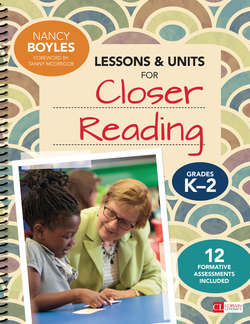Читать книгу Lessons and Units for Closer Reading, Grades K-2 - Nancy Boyles - Страница 10
На сайте Литреса книга снята с продажи.
Reading Closely in K–2 Guidelines for Getting Started
ОглавлениеSimply stated, close reading means uncovering layers of meaning in a text. In many respects, effective K–2 teachers have always engaged in the actions and outcomes of this practice, using conceptually rich, compelling fiction and nonfiction as the centerpiece of guiding students to read text and pictures well. So what’s different now? Well, to borrow from that famous ad, “This is not your mama’s K–2 reading!” We’ve amped it up, and some of the literacy field’s authors have helped describe it in a manner that is replicable in classrooms (Boyles, 2014; Fisher & Frey, 2013; Shanahan, 2012).
Close reading is one of those hot “trendy” topics in education that actually deserves a permanent place in K–12 classroom practice because, when implemented well, it really does help students to read and think analytically. In the intermediate and upper elementary grades and in secondary education, close reading has been widely embraced as a protocol that will help more students read more challenging texts, and the hope is that this will enable high school seniors entering college or the work force to be better prepared for the demands of 21st century careers. As you look out at your class of kindergarten, first, and second graders, who are still mastering the art of sitting still on the rug during read aloud, it’s hard to fathom that how you teach reading has a ripple effect on the reading proficiency of college seniors, but it does. That is, if we educators can use close reading as a cohesive, coherent practice K–12, it will actually make our teaching lives easier, and it will create a nation of readers, something we’ve been dreaming about for quite some time.
The question when working with K–2 students is not why but how? How will we start them on this path to close reading? Six- and seven-year-olds are generally not yet in a position to read complex texts on their own, or to annotate what they read like students in the upper elementary grades and beyond, or to process abstract thoughts without guidance. It’s all in the approach. So let’s think about exactly how we can make close reading happen in the primary grades using these six basic guidelines to get started:
1 Rely on high-quality picture books that you read aloud.
2 Teach an initial close reading lesson to build content knowledge.
3 Teach close reading follow-up lessons to build skills.
4 Assess close reading appropriately with formative assessments.
5 Teach close reading through units so students can make connections between texts.
6 Teach close reading through learning pathways that show students how to learn.
In short, this book, Lessons and Units for Closer Reading, Grades K–2, and its companion volume for Grades 3–6, are the “how,” painted on a canvas of picture book units. I work with hundreds of teachers each year, and their most common request is Give me a running start on close reading lessons and unit teaching. I don’t have time to figure out all the planning for this kind of teaching and to find all the great books that should be part of these units. So these lessons and units were developed to save you days and days of planning time and to let you in on the trade secrets of success I’ve learned. One important difference in this K–2 volume is the bank of reproducible formative assessments (see page 18 for more on their use).
Courtesy of Rick Harrington Photography
I made the Reader Response Frames and assessments a focal point of this K–2 book, in part because I realized the tremendous pressure on teachers to get students ready for the higher stakes assessments that begin in third grade. I also added them because I see how young learners love and often need these scaffolds as they begin their journey as readers, writers, and thinkers. Now let me walk you through each of these guidelines and explain how the lessons and units in this book support each one.
